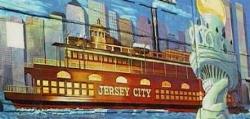 |  |  |
|
| ||
 |  |  |
 |  |  |
|
| ||
 |  |  |

 |
 |

Originally published in 1939
Some of this information may no longer be current and in that case is presented for historical interest only.
Edited by GET NJ, COPYRIGHT 2003
Ship Bottom-Harvey Cedars-Barnegat City; unnumbered road.
The road runs to the northern end of narrow Long Beach Island. Wave-worn timbers of wrecked sailing ships protrude from the sand of the lonely
beach, which in the northern section is unsurpassed for beauty by any other
part of the New Jersey Coast. During heavy winter storms much of the
island is flooded.
The route branches N. from State S40 (see Tour 35) at SHIP BOTTOM, 0 m. (10 alt., 277 pop.) (see Tour 35).
Northward at 0.8 m. is the widest part of Long Beach Island, nearly
1 mile broad, with the white sand beach (R) hidden from the road by a
long chain of low dunes with a few patches of wiry grass, half buried by
the shifting sand. The dunes shelter the villages from winter storms. In
the poor soil holly trees, wild roses, and mallows have a root-hold.
SURF CITY, 1.1 m. (1 5 alt.), is a small village with a few blocks of
boardwalk, some small hotels, and modern cottages. This resort was built
in 1873 around the site of the former Mansion of Health, oldest of the
island hotels.
Old-time sailing masters and pilots lived here when Surf City was a
port and a lumbering center. The earliest settlers on the island were
whalers, who came to this spot after obtaining a grant of land in 1690.
Two hundred years ago a whale watch pole, a post about 15 feet high
topped with a railed platform, stood on the beach. When a whale was
sighted the boats put out to make the capture. The mammals were beached,
stripped, and their blubber rendered on the sand.
HARVEY CEDARS, 3.7 m. (10 alt.), the island's oldest settlement,
drew whalers from Long Island and New England soon after the war of
1812. The jaw bone of a whale and fragments of the spine serve here
as a border for rose beds. Few of the old cedar trees are left. A large
NURSERY (L), where gladiolus and other flowers are grown under the
shelter of glass frames, is the brightest spot in town. For a quarter-century
a group of Philadelphia artists has maintained a summer colony in Harvey
Cedars. Their methods are business-like, yielding none of the arty atmos-
phere that characterizes similar colonies.
North of Harvey Cedars the route passes small clumps of stunted trees,
bent by ocean winds.
HIGH POINT, 4.5 m. (24 alt.), is a small village clinging to the
sheltered, sunset side of the low dunes. Gill nets are dried on stakes driven
into the sand.
Along the road are a few chicken coops containing specimens of one
of the peculiarities of Long Beach Island, the tailless rooster. The bitter
experience of Long Beach housewives has taught them the need for scissors: many a good Sunday dinner has been blown out to sea on a gusty
day when a vain cockerel, fancying himself an eagle in flight, has soared
too high. Tailless, this aviator is grounded.
LOVELADY, 6.4 m. (10 alt.), is chiefly a Coast Guard station. The
name, a source of discomfort to the Coast Guardsmen, derives from the
original owner, Thomas Lovelady, a well-to-do Englishman of the early
18th century.
BARNEGAT CITY, 8.5 m. (10 alt., 144 pop.), is a salty, individualistic Scandinavian fishing village adjoining a famous old lighthouse. Norse
names and features, blond, blue-eyed children, and leather-skinned seafarers, give the impression of a transplanted bit of Viking land. With
medieval simplicity the village manages to do without drug store, doctor,
police station, court, and motion-picture houses, centering its life around
a small church, a school, and a few taverns. Unruffled bartenders reassure
visitors during the fiercest gale, calling it "yoost a little blow."
The painter, F. Hopkinson Smith, caught the charm and independence
of these hardy people in his pictures and in his book, The Tides of Barnegat. Smith's father's firm built Barnegat Lighthouse (see below), and the
painter himself helped construct it. Annually hundreds of amateur deep-sea fishermen come here for the game tuna that swim in schools far off-shore. Neither they nor casual visitors can disturb the mild Scandinavian
tenor of life, which includes the substitution of spiritus frumenti for coffee
before the early morning trip across the dangerous bar to bring in the fish.
The ocean sometimes conspires with the natives to preserve the atmosphere
of the town. When some Philadelphia businessmen sought to convert it
into a resort, the waves destroyed the hotel and the railroad.
Barnegat shelters a race of tailless sea-going cats that eat the surplus
catch of the fishermen. The cats are descended from some Manx bob-tails
shipped as ratters on a bark that went ashore near the Coast Guard Station.
BARNEGAT LIGHTHOUSE (closed), 9.1 m. at the end of the road, was several hundred feet from the beach when built in 18 S5, but the inlet has cut a
channel to its base. The 168-foot tower, painted red on the upper half and
white below, marks the shoals where the lives of many Barnegat fishermen
and of passengers on ocean vessels have been lost. Storms have so menaced
the lighthouse's foundations that the Federal Government abandoned it in
1930, and replaced it with a lightship 8 miles off-shore. The State of New
Jersey then took over the tower and has attempted to save it by a semi-circle of steel sheet piling. The townspeople have dumped old automobiles, brush, and other refuse into the channel, to check erosion of the
sandy bank.
Ship Bottom to Barnegat City, 8.5 m.
Two-lane macadamized roadbed.
Numerous boarding houses and small hotels, some open all year.
|
Return To |
|

|